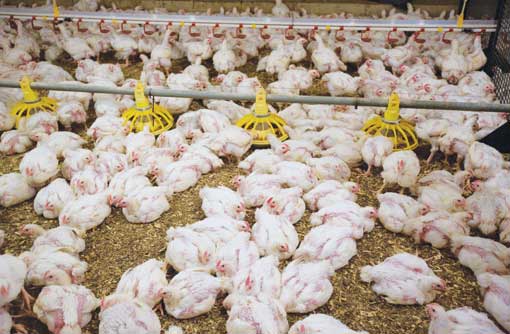Feed additives that pack a punch

With feed compounders making greater use of feed additives, Fiona Short of Optivite gives an overview of what they are and what they do
Feed additives are growing in importance as the poultry sector seeks to optimise the genetic potential of both broilers and layers to improve profit.
There are several types of additives including enzymes, antioxidants, acidifiers, omega-3 fatty acids and mycotoxin binders which all work to either improve the attractiveness of the feed or maximise nutrient availability.
ENZYMES
Enzymes are used in poultry feeds to increase digestibility and nutritive value.
They also enable nutritionists to use raw materials which would normally be unsuitable for poultry, due to the presence of anti-nutritive factors such as non-starch polysaccharide (NSP) and phytate.
The addition of NSP enzymes, such as xylanase and beta-glucanase, enables the breakdown of complex carbohydrate molecules into simpler ones, which the endogenous enzymes can then act on to realise more complete digestion.
Phytate enzymes act on the phytate molecule, the major phosphorus storage compound found in plants. Phytase added to the feed releases more of the unavailable phosphorus, so decreasing reliance on added inorganic phosphates.
ANTIOXIDANTS
Antioxidants are used to preserve the nutrient value of feed for the duration of its shelf life and to protect it from harsh storage conditions. There are two types of antioxidants, chemical and natural molecules.
Chemical antioxidants typically include ethoxyquin, butylated hydroxytoluene, butylated hydroxyanisole and/or propyl gallate.
Recently there has been an increased use of natural alternatives, such as rosemary extracts. They are typically high in tocopherols and/or anthocyanins, and are predominately found in red fruits.
Both chemical and natural antioxidants work by removing free radicals which can form potentially damaging hydroperoxide molecules. It is these molecules which, when further oxidised, give rise to the rancid smells associated with “off” feed.
ACIDIFIERS
Acidifiers are used in poultry feed to inhibit mould and control bacteria.
They suppress the proliferation of pathogenic bacteria such as E coli and salmonella, and prevent them from entering the intestinal tract, improving performance and reducing the potential for microbial contamination in the bird.
Protected or encapsulated acidifiers can work further along the digestive tract. The most widely used acids are formic, propionic and acetic.
They all work in the same way. The undissociated acid enters the bacterial cell, dissociates disrupting the intracellular pH which the bacteria then tries to correct by actively removing the hydrogen ions.
This leads to a build-up of the anionic part of the acid molecule which interferes with cellular metabolism and its replication mechanism, resulting in the death of the organism.
OMEGA-3 FATTY ACIDS
All modern livestock are deficient in omega-3 fatty acids due to the reduction or removal of fishmeal for cost and legislative reasons.
The increased use of cereals and vegetable protein based diets has led to an over-supply of omega-6 fatty acids. This imbalance can cause an exaggerated inflammatory response to a disease challenge, resulting in under performance.
The inclusion of an omega-3 source, such as salmon oil, helps to redress this balance and omega-3 fatty acids are associated with many positive benefits such as improved growth rates, food conversion, fertility, bone strength and enhanced omega-3 levels in meat and eggs.
Omega-3 fatty acids work through altering hormone production in favour of the anti-inflammatory hormones, reducing their excess pro-inflammatory counterparts.
MYCOTOXIN BINDERS
Mycotoxins are secondary metabolites produced by moulds and are some of the most toxic compounds known to man.
The six most commonly looked for are Aflatoxin B1, Fumonisin, Ochratoxin A, Deoxynivalenol (DON), Zearalenone and T-2.
They are rarely present individually and low levels can result in sub-clinical problems that cannot be put down to anything in particular. High levels can cause serious production issues and death.
Mycotoxins are routinely controlled by the inclusion of mycotoxin binders in feed.
There are three main types – mineral, organic and bio-transformers – which may include one or both of the above in conjunction with enzymes.
Mineral binders and biotransformers tend to be more active on the polar toxins such as Aflatoxin and Ochratoxin, whereas organic binders are more active on DON and Zearalenone.
The aim is that the toxin is bound irreversibly within or to the toxin binder and excreted from the body without being absorbed.
Fiona Short is a technical manager with feed and water additive company Optivite – a division of Anpario
